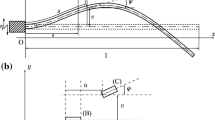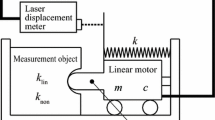Abstract
In this paper, we propose a sensorless amplitude control method for the self-excited oscillation by sensorless nonlinear feedback. Artificial self-excited oscillation by the feedback control is effective for vibrational microsensors because it can eliminate the viscous damping effect in measurement environments and realize the response with the linear eigenmode for the high sensitivity and accuracy of the measurements based on the shift of the linear natural frequency and mode such as AFM (atomic force microscopy). A sensorless feedback method was reported to produce the self-excited oscillation by using the interaction between the mechanical dynamics of the cantilever and the electrical dynamics of the piezoelectric device attached to the cantilever instead of the detection of the oscillation displacement with a sensor. However, there are no propositions of sensorless amplitude control. In the present study, we propose a sensorless nonlinear feedback to achieve the steady-state amplitude of the self-excited oscillation. The nonlinear feedback gain is designed by the theoretical analysis with the aid of the center manifold and the normal form theory. The efficiency is demonstrated through experiments using a macro-scale cantilever with a bimorph-type piezoelectric device. The results show the proposed nonlinear control can settle the oscillation amplitude to be finite in the steady state and change the magnitude depending on the nonlinear feedback gain.






Similar content being viewed by others
References
Babitsky, V.I.: Autoresonant mechatronic systems. Mechatronics 5(5), 483–495 (1995)
Babitsky, V.I., Kalashnikov, A.N., Molodtsov, F.V.: Autoresonant control of ultrasonically assisted cutting. Mechatronics 14(1), 91–114 (2004)
Li, X., Meadows, A., Babitsky, V., Parkin, R.: Experimental analysis on autoresonant control of ultrasonically assisted drilling. Mechatronics 29, 57–66 (2015)
Lalik, K., Dominik, I., Cwiakala, P., Kwasniewski, J.: Integrated stress measurement system in tower crane mast. Measurement 102, 47–56 (2017)
Balakirev, V.A., Borodkin, A.V.: Self-excited oscillations in a ubitron oscillator with delayed feedback. J. Commun. Technol. Electron. 56(1), 85–89 (2011)
Okajima, T., Sekiguchi, H., Arakawa, H., Ikai, A.: Self-oscillation technique for AFM in liquids. Appl. Surf. Sci. 210(1), 68–72 (2003). 5th International Conference on non-contact AFM in Montreal, Canada
Mouro, J., Tiribilli, B., Paoletti, P.: Measuring viscosity with nonlinear self-excited microcantilevers. Appl. Phys. Lett. 111(14), 144101 (2017)
Habib, G., Rega, G., Stepan, G.: Nonlinear bifurcation analysis of a single-dof model of a robotic arm subject to digital position control. J. Comput. Nonlinear Dyn. 8(1), 011009 (2012)
Villanueva, L.G., Karabalin, R.B., Matheny, M.H., Chi, D., Sader, J.E., Roukes, M.L.: Nonlinearity in nanomechanical cantilevers. Phys. Rev. B 87, 024304 (2013)
Spletzer, M., Raman, A., Wu, A.Q., Xu, X., Reifenberger, R.: Ultrasensitive mass sensing using mode localization in coupled microcantilevers. Appl. Phys. Lett. 88(25), 254102 (2006)
Yabuno, H., Seo, Y., Kuroda, M.: Self-excited coupled cantilevers for mass sensing in viscous measurement environments. Appl. Phys. Lett. 103(6), 063104 (2013)
Sato, M., Hubbard, B.E., Sievers, A.J., Ilic, B., Czaplewski, D.A., Craighead, H.G.: Observation of locked intrinsic localized vibrational modes in a micromechanical oscillator array. Phys. Rev. Lett. 90, 044102 (2003)
Dick, A.J., Balachandran, B., Mote, C.D., Jr.: Localization in microresonator arrays: influence of natural frequency tuning. J. Comput. Nonlinear Dyn. 5(1), 011002 (2009)
Nakamura, T., Yabuno, H., Yano, M.: Amplitude control of self-excited weakly coupled cantilevers for mass sensing using nonlinear velocity feedback control. Nonlinear Dyn. 99(1), 85–97 (2020)
Mondal, J., Chatterjee, S.: Controlling self-excited vibration of a nonlinear beam by nonlinear resonant velocity feedback with time-delay. Int. J. Non-Linear Mech. 131, 103684 (2021)
Sarkar, A., Mondal, J., Chatterjee, S.: Controlling self-excited vibration using acceleration feedback with time-delay. Int. J. Dyn. Control 7(4), 1521–1531 (2019)
Yang, L., Peng, J., Sun, F., Yang, J.: A nonlinear model for a self-powered electromechanical actuator using radioactive thin films. Microsyst. Technol. 27, 2229–2235 (2021)
Chen, J., Guo, H., Wu, Z., Xu, G., Zi, Y., Hu, C., Wang, Z.L.: Actuation and sensor integrated self-powered cantilever system based on TENG technology. Nano Energy 64, 103920 (2019)
Alhazza, K.A., Daqaq, M.F., Nayfeh, A.H., Inman, D.J.: Non-linear vibrations of parametrically excited cantilever beams subjected to non-linear delayed-feedback control. Int. J. Non-Linear Mech. 43(8), 801–812 (2008)
Roshandel, N., Soleymanzadeh, D., Ghafarirad, H., Sadri Koupaei, A.M.: A modified sensorless position estimation approach for piezoelectric bending actuators. Mech. Syst. Signal Process. 149, 107231 (2021)
Leadenham, S., Erturk, A.: Unified nonlinear electroelastic dynamics of a bimorph piezoelectric cantilever for energy harvesting, sensing, and actuation. Nonlinear Dyn. 79(3), 1727–1743 (2015)
Li, J., He, X., Yang, X., Liu, Y.: A consistent geometrically nonlinear model of cantilevered piezoelectric vibration energy harvesters. J. Sound Vib. 486, 115614 (2020)
Chen, Y., Yan, Z.: Nonlinear analysis of unimorph and bimorph piezoelectric energy harvesters with flexoelectricity. Compos. Struct. 259, 113454 (2021)
Tanaka, Y., Kokubun, Y., Yabuno, H.: Proposition for sensorless self-excitation by a piezoelectric device. J. Sound Vib. 419, 544–557 (2018)
Urasaki, S., Yabuno, H., Yamamoto, Y., Matsumoto, S.: Sensorless self-excited vibrational viscometer with two Hopf bifurcations based on a piezoelectric device. Sensors 21(4), 1127 (2021)
Guckenheimer, J., Holmes, P.: Nonlinear Oscillations, Dynamical Systems, and Bifurcations of Vector Fields, vol. 42. Springer, Berlin (2013)
Steiner, W., Steindl, A., Troger, H.: Center manifold approach to the control of a tethered satellite system. Appl. Math. Comput. 70(2), 315–327 (1995)
Nayfeh, A.H.: The Method of Normal Forms. Wiley, Hoboken (2011)
Wei, W., Yabuno, H.: Subcritical Hopf and saddle-node bifurcations in hunting motion caused by cubic and quintic nonlinearities: experimental identification of nonlinearities in a roller rig. Nonlinear Dyn. 98(1), 657–670 (2019)
Acknowledgements
This study was supported in part by a Grant-in-Aid for Scientific Research B (Grant No. 19H0209B) from the Japan Society for the Promotion of Science (JSPS). We would like to thank Mr. Yudai Tanaka for useful discussions of the theoretical analysis. Further, we thank Mr. Keyu Zhou for his experimental supports.
Author information
Authors and Affiliations
Corresponding author
Ethics declarations
Conflict of interest
The authors declare no conflicts of interest. The datasets generated during and/or analyzed during the current study are available from the corresponding author on reasonable request.
Additional information
Publisher's Note
Springer Nature remains neutral with regard to jurisdictional claims in published maps and institutional affiliations.
Appendices
A Derivation of nonlinear function N
The nonlinear functions \(\left[ N_1, ~N_2, ~N_3, ~N_4 \right] ^\mathrm{T}\) in Sect. 2.2 can be derived as
where their elements are:
These elements \(C_{11000}, C_{10100},\ldots , C_{40003}\) are too massive not to explicitly show in the manuscript, but they consist of the original state vector \(\left[ a^{*} ~ \dot{a}^{*} ~ V_\mathrm{LPF}^{*} ~ \dot{V}_\mathrm{LPF}^{*} \right] ^\mathrm{T}\) and the dimensionless parameters defined in Eq. (8).
B Coefficients of the center manifold
In this section, we show the determination process of the coefficients \(D_{310}, ~D_{301},\ldots , D_{403}\). Taking derivative with respect to the dimensionless time \(t^*\) of Eq. (12) is expressed as
which is also expressed in the third row of Eq. (11):
Equating Eqs. (30) and (31) yields following relationships that the coefficients \(D_{310}, ~D_{301},\ldots , D_{303}\) satisfy:
Similarly, equating
and
yields
C Reduction in the number of nonlinear terms
We select the coefficients \(Q_{10}, Q_{01},\ldots , Q_{03}\) in the equation governing \(\xi \), Eq. (19). The derivative of z and \(\overline{z}\) with respect to \(t^*\) is
Substituting Eq. (47) into Eq. (46) yields
To reduce the number of nonlinear terms in the equation, we select the coefficients as
Then, Eq. (16) is simplified as Eq. (21).
Experimentally obtained characteristics for nonlinear feedback gain \(\beta _\mathrm{NL}\) versus oscillation amplitude of the cantilever when the linear feedback gain \(\beta _\mathrm{NL}\) is fixed near the critical value for the self-excited oscillation; \(\beta _\mathrm{lin} = 109 \times 10^{-10}\). Blue and red markers show the experimentally obtained and theoretically calculated response amplitudes, respectively. The theoretical amplitudes are calculated by using Eqs. (10), (14), (15), (19) and \(v(x,t) = a_1(t) \varPhi _1(x)\)
D Quantitative comparison between experimental and theoretical results
We compare the experimentally and theoretically obtained amplitudes quantitatively. Figure 7 shows the oscillation amplitude when the linear proportional and derivative feedback gains are set at \(\alpha = -2.68 \times 10^{-5}\) and \(\beta _\mathrm{lin} = 109 \times 10^{-10}\), where the blue and red markers denote the experimentally and theoretically obtained values, respectively. Namely, the blue markers correspond to the amplitude at \(\beta _\mathrm{lin} = 109 \times 10^{-10}\) in Fig. 6 . The experimental and theoretical oscillation amplitudes have a quantitative discrepancy. Such a difference is caused by the difficulty in quantitative identification of the parameter \(\psi \). Overcoming this difficulty is an open problem. Moreover, the experimentally obtained trend of the response amplitude depending on the nonlinear feedback is in a qualitative good agreement with the theoretical one. It is not necessary to know the nonlinear feedback gain precisely because we can flexibly tune the nonlinear feedback gain to realize the desired magnitude of the steady-state amplitude in practical systems.
Rights and permissions
About this article
Cite this article
Urasaki, S., Yabuno, H. Amplitude control for sensorless self-excited oscillation of cantilever based on a piezoelectric device. Nonlinear Dyn 108, 15–25 (2022). https://doi.org/10.1007/s11071-021-07181-w
Received:
Accepted:
Published:
Issue Date:
DOI: https://doi.org/10.1007/s11071-021-07181-w





